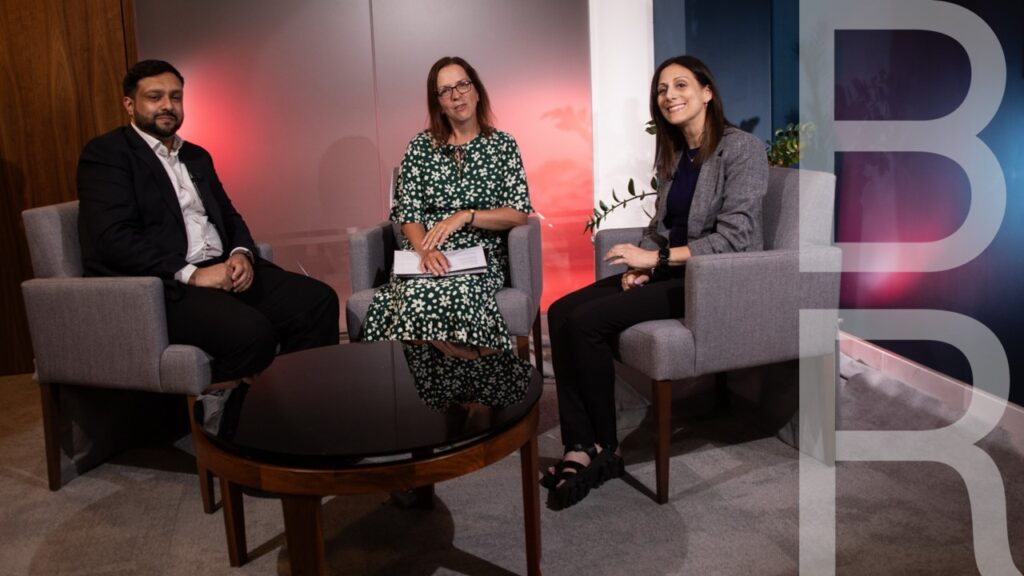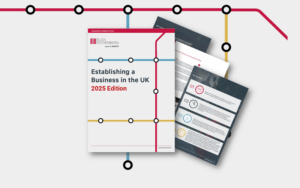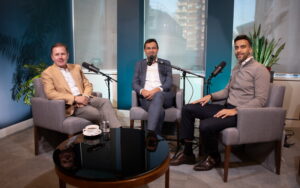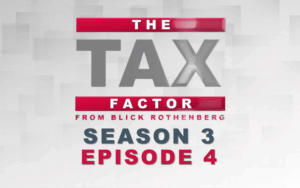Welcome to our MTD hub, where you can find all the latest information and resources on Making Tax Digital

Making Tax Digital
Making Tax Digital
Making Tax Digital is the UK Government’s initiative to improve the quality and timeliness of information that HM Revenue & Customs (HMRC) receives
Self-employed individuals and landlords who meet the criteria will need to keep digital records and file quarterly returns to HMRC followed by an end of year return.
The principle behind the move to Making Tax Digital (MTD) is that whilst records are held digitally and communicated to HMRC more regularly, the risk of errors is reduced.

April 2026 changes – Be prepared
From 6 April 2026, HMRC’s Making Tax Digital for Income Tax Self-Assessment (MTD ITSA) will be mandatory for sole traders and landlords earning over £50,000 annually.
Suzanne Briggs, Private Client Partner, Stephanie Levin, Head of Entrepreneurial Services and Audit, Accounting and Outsourcing Partner and Mitesh Khoot, Private Client Manager discuss what impacted individuals should be doing now to prepare for the changes.
The way income tax self-assessment returns are submitted with HMRC is changing. The UK Government’s initiative aims to modernise the tax system by replacing the traditional annual tax return with digital record-keeping and quarterly updates via compatible software. Instead of one yearly submission, you’ll now need to maintain digital records, submit quarterly updates, and file an End of Period Statement and Final Declaration each year.
Start preparing by exploring MTD-compliant software, reviewing your current record-keeping process, and speaking to your accountant or advisor early. Now’s the time to get ahead.

Making Tax Digital for Income Tax
MTD for Income Tax is due to start apply from April 2026 (subject to certain thresholds) and will broadly consist of three elements;
- Digital Records
- Quarterly Updates
- A Year-End Declaration
Who needs to comply with Making Tax Digital for Income Tax
Sole traders and landlords will be within the scope of Making Tax Digital for Income Tax (MTD for IT) from April 2026, however, this will be phased based on their qualifying income as follows:
From April 2026, those with qualifying income over £50,000
From April 2027, those with qualifying income over £30,000
From April 2028, those with qualifying income over £20,000
Sole traders and landlords with qualifying income below £20,000 will not be within the scope of MTD for Income Tax for the time being. However, it is the governments intention to include individuals in this category in the future.
Please note that when assessing qualifying income against the thresholds, the combination of both self-employed income as well as rental income must be taken. An example of this is illustrated below:
| Scenario | When does MTD apply? |
| £50,000 rental and/or self-employed income | April 2026 |
| £20,000 rental income + £20,000 self-employed income | April 2027 |
| £10,000 rental income + £15,000 self-employed income | April 2028 |
| £10,000 rental income+ £10,000 self-employed income | Currently outside of MTD |
Qualifying income is the total gross income arising in a tax year from self-employment and property income
In addition to this the following will also count as qualifying income:
For private equity executives – Disguised Investment Management Fees and/or Income based carry will count as qualifying income. Additionally, with the proposed changes to the treatment of carry, it is not yet known if carry payments will also count as qualifying income.
For beneficiaries – Beneficiaries of bare trusts and interest in possession trusts will need to include any property or trading income that they are entitled to or are paid directly (in the case of interest in possession trusts).
HMRC have confirmed that the following sources will not count as qualifying income:
- Individuals impacted by the basis period reform where transitional profits have been split over five tax years
- Carers in receipt of qualifying care receipts
Qualifying income will be assessed based on the last submitted tax return.
For example, to assess the qualifying income for the 2026/27 tax year, the 2024/25 tax return (i.e., the return due for submission by 31 January 2026) will be used. HMRC will review the return and let the taxpayer know when they must start using Making Tax Digital for Income Tax.
Once an individual has fallen within the threshold for MTD for IT, they can only become exempt if their qualifying income falls below the threshold for three consecutive tax years.
Qualifying income will be assessed based on the last submitted tax return.
However, there will be cases where it may be possible to apply for exemption earlier, but that will be in cases where it is not practical to comply with MTD for IT, such as if the individual has ceased to trade or they are in the process of winding down with substantially low profits.
This has long been an area of concern, however, HMRC have now provided some clarity on this.
There will be two different easements available to ease the burden on joint property owners, especially where perhaps only one of the joint owners falls with the scope (as they also have self employed income). The easements will be as follows:
Quarterly submission easement – (reporting income quarterly but expenses only once a year)
Three-Line accounting easement – (records items as income or expense only – no categorisation of expenses required)
Get in touch for more information on how this might work for you.
This easement will also be available for self-employed individuals who are below the VAT registration threshold and will work in the same manner as the easement for joinly held property.
The individual in this instance would record items are income or expense only. Categorising expenses will not be required under this easement.
Yes, however, there are exemptions for individuals that fall into specific categories (i.e., foreign entertainers / sports people, etc.)
For individuals that complete the residency pages as part of their tax return, a one year deferment to April 2027 will be available. More information on this deferment including if it will apply automatically or require claiming, is expected to be available in due course.
An exemption is available for those that fall within the definition of digitally excluded.
This would be those who do not use computers for religious reasons or those unable to use computers due to age, disability or location.
Further guidance is expected to be made available on this prior to MTD for IT becoming mandatory from April 2026.
The individual will have one month after the period end date to send in a quarterly update (as illustrated below).
Each update is cumulative over the tax year, therefore, corrections or adjustments to previous updates can be made at the next update. i.e., if two quarterly updates have been filed and an error is then noticed in either of those updates, the position can be corrected in the third quarters update.
7 August
Quarter 1 – Period covered: 6 April to 5 July
7 November
Quarter 2 – Period covered: 6 July to 5 October
7 February
Quarter 3 – Period covered: 6 October to 5 January
7 May
Quarter 4 – Period covered: 6 January to 5 April
31 January
Final Declaration
Digital records are the foundation of MTD for Income Tax. The requirement to keep digital records will not mean that taxpayers have to copy, scan and digitally store their receipts. Individuals can continue to keep paper copies, but each transaction will have to be recorded and stored digitally.
The above can be done using software such as Xero (which is MTD compliant), but Excel can also be used (albeit Bridging software must be used with this method).
Transaction details such as the amount, category and date of income and expenses of the trade or property business much be recorded for each quarter.
Late filing penalties under MTD for Income Tax
A new system for penalties has been implemented with the introduction of MTD for Income Tax
The new penalty system is already in place for MTD for VAT.
Once MTD for Income Tax has become compulsory, the new system will apply to that too.
The new penalty regime will operate on a points system rather than an immediate charge as is currently the case. Once an individual has accumulated a certain number of points an automatic £200 penalty will be applied.
Each time a deadline is missed a penalty point will be applied.
The threshold of points for a penalty to apply will depend on the frequency of filing:
| Frequency of filing | Points threshold |
| Monthly | 5 |
| Quarterly (This will apply for MTD for ITSA) | 4 |
| Anually | 2 |
If an individual is VAT registered and is also required to file under MTD for Income Tax, then it is possible to get a penalty under MTD for Income Tax as well as under VAT if the required points are met.
When do the points ‘reset’?
Penalty points drop away after two years starting from the month after the month in which the penalty point was received.
If within this two-year period, an individual has had the £200 penalty applied then the points do not drop away. Instead, the individual must demonstrate ‘good behaviour’, i.e., they must have met all submission deadlines going forward.
The length of the period in which ‘good behaviour’ must be demonstrated is based on the frequency of filing as follows:
| Frequency of filing | Period of ‘good behaviour’ |
| Monthly | 6 Months |
| Quarterly (This will apply for MTD for ITSA) | 12 Months |
| Annually | 24 months |
Late payment penalties
With the new system for late submission penalties, a new late payment penalty system will also apply.
The new late payment system is far heavier handed than the current late payment system and will apply as follows:
Up to 15 days after the payment was due:
No Penalty
More than 15 days but less than 30 days after the payment was due:
3% of the outstanding tax due
Day 31 after payment was due:
3% of the outstanding tax due at day 15 plus 3% of the tax outstanding due at day 30
More than 31 days after payment was due:
10% per annum of the outstanding tax due levied each day the balance is outstanding after day 30
Making Tax Digital for VAT
MTD for VAT came into force for most VAT businesses from 1 April 2019 with the digital links soft landing period having ended on 1 April 2021.
VAT registered businesses with turnover below £85,000, were bought into the MTD regime from 1 April 2022.
The VAT rules require that throughout the VAT return preparation there are digital links end-to-end.
A “digital link” is one where the transfer of data is electronic as opposed to manual. The principle being that no data in connection with the VAT return is manually copied or re-keyed.
HMRC accepts that the following are digital links (non-exhaustive):
- XML, CSV import and export and download and upload of files
- API transfer
- Automated data transfer
- Emailing a spreadsheet containing digital records
If you are already using a software package, ask your vendor if it is MTD compatible.
You may need to upgrade or install an add-on to enable the functionality.
If it is not compliant and/or you are not able to upgrade, you can either change your package, or export the relevant VAT return information to excel and use bridging software each quarter.
If your excel spreadsheets contain sufficient information to comply with the MTD accounting records requirements there is no need to change to accounting software. You will need to use bridging software to submit your VAT returns to HMRC.
Notwithstanding the above, you may wish to use this opportunity to move to an accounting software package, to provide you with more real time management information, which may assist when making business decisions.
No, you can maintain your invoices and underlying documents in paper form should you wish.
HMRC only receive the same information contained in the 9 boxes that are on the VAT return.
They do not receive the detailed listing of transactions as part of the quarterly submission.
Where you need to apportion the output tax due on a mixed rate supply with a single inclusive price you do not have to record these supplies separately. You can record the total value and the total output tax due.
Not all software will allow you to record a rate of VAT other than the standard, reduced or zero/exempt. If this is the case, this mixed supply should be recorded as either one standard rated supply and one zero rated supply, or you can record the sale at one rate and correct the VAT through an adjustment at the end of the period. You will also need to do this if you are using a margin scheme or the flat rate scheme.














